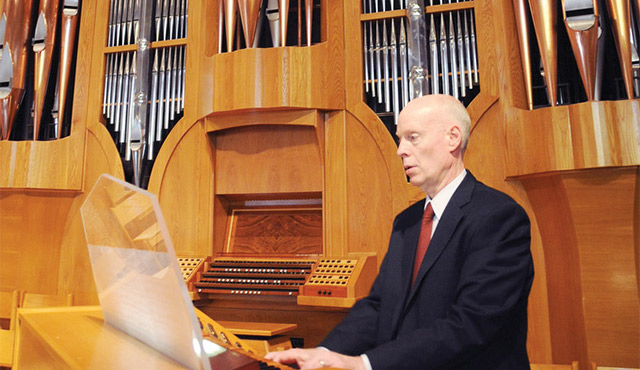ARLINGTON, Va. (CNS) — From the softest pianissimo to the most dramatic swells of sound, the pipe organ’s range and capacity to lift the voice and spirit accord it “pride of place” among instruments used in Catholic liturgy.
It “gives resonance to the fullness of human sentiments, from joy to sadness, from praise to lamentation,” said Pope Benedict XVI in 2006 during an organ blessing. “The manifold possibilities of the organ in some way remind us of the immensity and the magnificence of God.”
But recent headlines strike a somber note for the majestic instrument: “As number of church organists declines, fears of a dying art”; “Soaring instrument appeals to fewer churches”; “The decline of the church organ.”
Although some trends support this bleak outlook, but the status of the pipe organ in the U.S. church is more optimistic than the headlines suggest.
“Overall, the state of organ music is positive and uplifting,” said Paul Skevington, past chairman of the National Association of Pastoral Musicians’ section for organists. “It’s not going anywhere; it’s simply becoming part of the bigger mosaic.”
Skevington is director of music and liturgy at St. Luke Church in McLean and former dean of the Northern Virginia Chapter of the American Guild of Organists.
The number of organ players has decreased in recent decades. Membership has gone down in the American Guild of Organists, which includes academic, concert and church organists, and the National Association of Pastoral Musicians, which serves as a resource for Catholic pastoral musicians.
Interest in studying the organ has also waned. Data compiled by the College Music Society shows that the number of students seeking a master’s degree in organ performance in the United States fell nearly 14 percent from 2012 to 2013, and fewer students are entering bachelor’s and doctorate programs in organ performance.
But Skevington said the problem is not a shortage of organists but a dearth of full-time, well-paying church organist positions.
“At universities and at the national level, there’s a big commitment to organ music, but when it comes down to the parish level, then you have to make decisions, and I think oftentimes music does not receive the priority that it should,” he told the Arlington Catholic Herald, the diocesan newspaper.
Skevington said that funding a full-time organist always has been a challenge for smaller parishes, but as “the income gap between the 1 percent and 99 percent widens, young people pay more attention to the profession they are going into.”
According to John Romeri, director of liturgical music for the Philadelphia Archdiocese and past chairman of the National Association of Pastoral Musicians, some new parishes are not leaving space in their building plans for the pipe organ, because the instruments are pricey and dip into strained parish budgets.
David Mathers, director of sacred music at St. Mary of the Immaculate Conception Church in Fredericksburg and chairman of the Arlington diocesan chapter of the National Association of Pastoral Musicians, estimates an organ like the one at St. Mary can cost between $500,000 and $3 million.
“We need to help parish building committees understand why the organ is worth the expense and important,” said Mathers.
The General Instruction of the Roman Missal states that while other instruments may be used in liturgical services, the “organ is to be accorded pride of place.”
Some blame the Second Vatican Council for the organ’s fall from this revered place. Mathers said such blame would be misplaced, but that Vatican II indirectly contributed to new challenges for the organ by placing more emphasis on liturgical participation and leaving musical style up to local communities.
“There were churches that literally tore out organs and put them in dumpsters,” he said. “There was a big cultural shift.”
But he noted that people are “now examining what was left behind and what could be brought back.”Richard Parsons, president of the Associated Pipe Organ Builders of America, said that while fewer organs are being built nationally, the industry is doing well.
There are “still bands in church, but people want tradition, too,” said Parsons. “Right now we are seeing a swing” of the pendulum back to people wanting classical sounds.
And those who are taking up the instrument have a great passion for it.
“Thirty years ago, young people and seminarians wanted to play the guitar. Now they are interested in sacred music and the organ,” said Romeri.
Richard Gibala, director of music at the Cathedral of St. Thomas More in Arlington and music coordinator for the Arlington Diocese, said he sees “a lot of interest in young people in Gregorian chant, the organ, in bringing back music that is our tradition.”
The pipe organ is here to stay, he said. “The organ is the voice of the church.”
“Young people are interested in offbeat things and are fascinated by the organ,” added Mathers. “Once they hear it and feel its power” they are drawn toward it. “That’s why having a pipe organ in a parish is so critical.”
The National Association of Pastoral Musicians and American Guild of Organists are reaching out to young people to further cultivate interest in the instrument with weeklong summer courses and mentoring programs.
John Mitchell, a junior studying sacred music and the organ at Westminster Choir College in Princeton, New Jersey, acknowledged that the organ isn’t as popular as the electric guitar with teenagers but his feelings for the instrument burgeoned as he heard it played each Sunday.
“It sounded so beautiful — the contrast between the raw power and quietness — and its ability to lead people in song, community and worship.”
Scott is a staff writer at the Arlington Catholic Herald, newspaper of the Diocese of Arlington.

